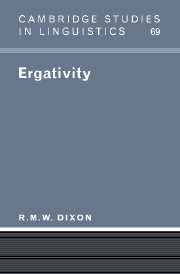Book contents
- Frontmatter
- Contents
- Preface
- Acknowledgements
- Appeal
- List of abbreviations
- 1 Introduction
- 2 Syntactically based and semantically based marking
- 3 Intra-clausal or morphological ergativity
- 4 Types of split system
- 5 The category of ‘subject’
- 6 Inter-clausal or syntactic ergativity
- 7 Language change
- 8 The rationale for ergativity
- Appendix: A note on theoretical models
- References
- Index of authors
- Index of languages and language families
- Subject index
Preface
Published online by Cambridge University Press: 06 July 2010
- Frontmatter
- Contents
- Preface
- Acknowledgements
- Appeal
- List of abbreviations
- 1 Introduction
- 2 Syntactically based and semantically based marking
- 3 Intra-clausal or morphological ergativity
- 4 Types of split system
- 5 The category of ‘subject’
- 6 Inter-clausal or syntactic ergativity
- 7 Language change
- 8 The rationale for ergativity
- Appendix: A note on theoretical models
- References
- Index of authors
- Index of languages and language families
- Subject index
Summary
I never intended to work on ergativity. The topic more or less crept up on me, embraced me, and has never really relaxed its hold. Not that I am complaining – working on ergativity has provided the most intense intellectual satisfaction.
When I first went out to Australia to study an indigenous language, in 1963, the word ‘ergative’ wasn't in my linguistic vocabulary. The Australian Institute of Aboriginal Studies suggested working in the Cairns Rain Forest region and I chose Dyirbal for my major focus of study simply because it was the language with the most speakers (perhaps 100 fluent speakers, at that time). When I returned to London and explained the structure of Dyirbal to M. A. K. Halliday he told me that these unusual-looking grammatical patterns I had uncovered were ‘ergative’. It was only on a return field trip in 1967 that it was brought home to me how thoroughly ergative Dyirbal is at the syntactic level (as well as being split-ergative at the morphological level).
John Lyons, external examiner for my PhD thesis on Dyirbal (submitted in December 1967), was at that time editor of the Journal of Linguistics and he invited me to submit a paper on ergativity in Dyirbal. I planned to do so, ahead of publishing the full grammar, since it seemed to me that people were more likely to take note of a short article in a leading journal than of something hidden away in a long monograph.
- Type
- Chapter
- Information
- Ergativity , pp. xiii - xviiPublisher: Cambridge University PressPrint publication year: 1994



